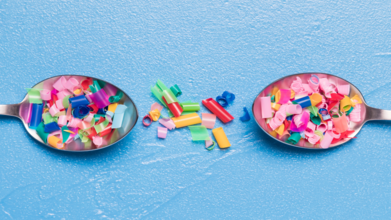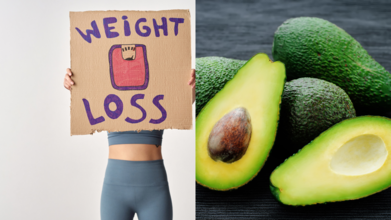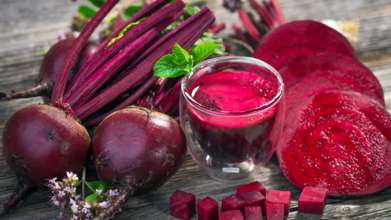- Health Conditions A-Z
- Health & Wellness
- Nutrition
- Fitness
- Health News
- Ayurveda
- Videos
- Medicine A-Z
- Parenting
- Web Stories
Microplastics Are Invading Your Brain: Here's How To Filter Them Out Of Your Drinking Water

Credits: Freepik
Small pieces of plastic, microplastics and their minute variations, nanoplastics—are appearing in some of the most unlikely locations: from the tops of mountains to the bottoms of the ocean's deepest trenches, and now, within the human body. Researchers have found these particles in lungs, placentas, blood vessels, and recently, in brain tissue, over the last decade. The results are disquieting, but the science still needs to catch up to describe precisely how these plastics are affecting us.
Increasing evidence is pointing to potential connections between exposure to microplastics and cardiovascular, neurological, and metabolic health hazards. Meanwhile, other research is investigating simple solutions, such as boiling tap water, to reduce the amount of plastic we consume. Together, these two lines of scientific inquiry—identifying risks and field-testing simple solutions—are fueling a public health dialogue that can no longer be dismissed.
Why Are Microplastics Everywhere?
Microplastics are plastic pieces less than 5 millimeters in size, and nanoplastics measure in billionths of a meter. Microplastics can come from littered packaging, plastic clothing fibers, broken-down plastic bottles, or industrial pollutants. Once released into the environment, they become transported by wind, flow into groundwater, or accumulate in the food chain through fish, meat, and vegetables.
The most headline-grabbing discovery came earlier this year when researchers reported finding microplastics in donated human brain tissue. The study, published in Nature Medicine, compared brain samples collected in 2016 with those from 2023. The later samples contained far higher concentrations, suggesting accumulation is accelerating over time. The top researcher, US toxicologist Matthew Campen, estimated that up to 10 grams of plastic—about the size of a small crayon—could be separated from one human brain.
If that's correct, the implications are staggering: microplastics could be penetrating the blood-brain barrier, the body's natural protective mechanism meant to prevent unwanted substances from entering.
Why Are Experts Advising Caution?
Not everyone is convinced by these initial results. Toxicologists like Theodore Henry at Heriot-Watt University have called for caution, citing the fact that the evidence base is still thin and confirmation is required. Others, like chemist Oliver Jones of RMIT University, say it's not likely brains will have more microplastics than raw sewage, as some estimates suggested. Significantly, the people involved in these investigations were otherwise healthy at the time of death, and no direct proof was found to connect microplastics with disease.
Nevertheless, more scientists are cautioning against holding off until they are absolutely sure. Observational studies, though not conclusive, are sounding the alarm. For example, a study in the New England Journal of Medicine associated microplastic deposits in arteries with increased risks of heart attack, stroke, and death among patients with artery disease. In animal models, microplastics have caused blood clots, disrupted cell function, and even changed gut microbiomes.
The World Health Organization has concluded that evidence is still "insufficient to determine risks to human health." But as the Barcelona Institute for Global Health emphasized in a 2024 report, "policy decisions cannot wait for complete data."
The sense of urgency comes from the sheer volume of plastic manufacturing. Since 2000, production has doubled and is projected to triple yet again by 2060. Each phase of the plastic lifecycle—production through disposal—emits microscopic particles that find their way into air, soil, and water. That means people are exposed all the time, usually unknowingly.
It could be particularly at risk for children, pregnant women, and individuals with underlying medical conditions. Even if microplastics are not as dangerous as everyone has feared, the sheer number of people exposed across the world means it's an important public health concern.
Simple Ways To Remove Microplastics From Water
Although the long-term health impacts are disputed, scientists are starting to find simple measures to cut down on daily exposure. A 2024 research report from Guangzhou Medical University and Jinan University in China discovered that boiling tap water prior to consumption could filter out as much as 90 percent of nanoplastics and microplastics, depending on how many minerals the water contained.
This is how it goes, hard tap water (high in calcium carbonate) is boiled, and limescale is created, catching plastic pieces within. The encrusted pieces can then be strained out with as much as a stainless-steel strainer or a tea mesh. Even soft water resulted in a decrease of approximately 25 percent of plastic after boiling.
The findings, reported in Environmental Science & Technology Letters, indicate that a common home practice of boiling water might be one of the most readily available protections against microplastic contamination. It's not an end-all solution but is something anyone can do without needing fancy equipment.
Drinking water is just half the story. Microplastics have been found in bottled water, seafood, table salt, honey, and even fresh vegetables. Cooking in non-stick pans, reheating food in plastic containers, and eating packaged foods can all contribute to the body's plastic load.
Boiling water, therefore, must be seen as a complementary approach, not a panacea. Experts suggest that it be used in combination with larger strategies, including less plastic packaging, spending on high-tech municipal filtration plants, and urging industry to change to biodegradable materials.
Microplastics have come to dominate global disputes about plastic pollution. As UN member nations finalize the world's first treaty to limit plastic waste, health science has taken on a growing prominence. Policymakers are being called upon to balance precautionary action, even without conclusive evidence of harm.
Activists contend that waiting for decades worth of data would be risky considering how fast plastics are piling up in the environment and in human bodies. Instead, they advocate a two-pronged strategy of drastic curtailment of plastic manufacture and real-world steps to restrict personal exposure.
THIS Is The Only Right Way To Store Leftover Rice If You Do Not Want To Fall Seriously Sick

Credits: Canva
For many, cooking rice is the easiest job and for the right reasons, you can cook a lot and store it for later. But the problem is not that; it is about how you store it. Lurking in your pile of grains is a hidden bacterium called Bacillus cereus. It thrives on raw rice and survives even after cooking. And the alarming bit is that if you do not store your rice correctly, this bacterium can multiply, releasing toxins that can cause food poisoning.
Food poisoning could lead to vomiting, diarrhoea, cramps, and, in rare cases, infections so severe they can cause organ failure. It is scary, but the worst part is that you cannot see, smell, or taste the danger. A bowl of rice can look perfectly fine while it can quietly wreak havoc in your stomach.
A common thing we all do is leave the leftover rice in the kitchen or on the dining table with just a lid on. But it is more than that, and it is the temperature that plays an important role. So, we are making a huge mistake if we leave it at room temperature.
Here is the safer way to deal with leftover rice and cut the risk of falling seriously sick:
Unlike pasta or potatoes, rice is classed as a high-risk food once cooked. In commercial kitchens, chefs treat it with caution. It is rarely kept overnight and almost never used the next day. That is because of Bacillus cereus and its stubborn little spores.
The Spores That Survive the Heat
Cooking rice does not wipe out Bacillus cereus. The spores are heat-resistant, which means they are still alive and kicking after you have drained your pan. Once the rice cools down, those spores can multiply into bacteria at lightning speed. The longer your rice sits at room temperature, the more the bacteria multiply. And unfortunately, their toxic by-products do not just disappear when you put the rice in the microwave.
Reheating rice does not make it safe. The toxins Bacillus cereus produces are heat-stable. They survive your microwave, oven, or stove reheat session. That means the rice could look fine, taste fine, and even smell fine, but still make you sick.
The Common Storage Mistake
Where do most people go wrong? They leave the rice out too long before refrigerating it. That is more than enough time for Bacillus cereus to thrive and pump toxins into your rice. The second mistake is thinking that reheating alone will make it safe. Unfortunately, it will not. As TikTok chef Joshy Jin says, those toxins are invisible, tasteless, and can survive heating. A bowl that looks perfectly fine can knock you down with food poisoning in just hours.
How to Store Leftover Rice the Right Way
If you must keep leftover rice, speed is everything. Here is what food safety experts and chefs recommend:
- Cool it fast. Spread the rice out on a plate or baking tray so it cools within 10 minutes. Clumping it in a pot traps heat and gives bacteria time to multiply.
- Refrigerate quickly. Once it is no longer steaming, cover it and get it into the fridge. Do not leave it hanging out on the counter.
- Stick to the 24-hour rule. The Food Standards Agency advises eating refrigerated rice within one day. Some chefs say two, but the fresher, the safer.
- Reheat until piping hot. If you do reheat, make sure it is steaming all the way through, not just lukewarm in the middle.
Fresh is Best Any Day
Rice is deceptively dangerous when it comes to leftovers. Bacillus cereus spores are survivors, and once they release toxins, no amount of reheating can save your meal. The safest thing to do is to cook only what you need. If you are planning fried rice tomorrow, store it properly, cool it fast, and keep it in the fridge for no longer than a day. But otherwise, embrace the ritual of fresh rice-making.
Does How You Eat Avocado Affect Its Weight-Loss Benefits?

Credits: Canva
From sourdough toast to green smoothies, this creamy fruit has secured its spot as a global wellness icon. Packed with healthy fats, fibre, and enough Instagram clout to fill a mood board, it’s touted as a weight-loss-friendly superstar. But does the way you eat avocado really affect its slimming benefits, or is guac just guac no matter how you scoop it?
The Nutrient Profile That Makes Avocado Shine
One medium avocado carries around 240 calories, 21 grams of fat, and 10 grams of fibre. The fat is mostly monounsaturated (the heart-healthy kind that keeps you full), while the fibre slows digestion, stabilises blood sugar, and helps curb cravings. According to nutritionists, these factors make avocados weight-loss friendly. But how you prepare, pair, and portion this fruit can make or break its benefits.
Raw, Toasted, or Mashed: Does Form Matter?
Eating avocado raw is the cleanest way to enjoy its nutrients, like slices in a salad or scooped straight from the skin with a spoon. When you mash it into guacamole, you don’t lose nutrients, but the add-ins matter. A sprinkle of lime, tomato, and onion? Perfectly harmless. A mountain of salt and tortilla chips on the side? Suddenly, your “weight-loss snack” turns into a salt-and-carb bomb. Toasting avocado, meanwhile, doesn’t strip its healthy fats, but frying or cooking it in oil can double down on calories, leaving you with more fat than you bargained for.
The Avocado-Toast Trap
Avocado toast may look Instagram-worthy, but it’s a calorie load. Slathering half an avocado on sourdough bread topped with cheese, eggs, or smoked salmon can push a single “light” meal over 500 calories. Not exactly waist-friendly if you’re trying to keep a deficit. On the flip side, pairing avocado with a slice of wholegrain bread, a squeeze of lemon, and maybe a sprinkle of chilli flakes gives you fibre, healthy fats, and flavour without blowing your calorie budget. It’s not just what you eat, but what you eat it with.
Smoothies?
Avocado in smoothies is genius. It adds creaminess, fibre, and satiety and balances out the sugar hit from fruits like banana or mango. But blending avocado with nut butter, protein powder, honey, oats, and coconut milk. Suddenly your “green smoothie” becomes a 700-calorie dessert in disguise. To keep it waist-friendly, stick to half an avocado, a handful of spinach, unsweetened almond milk, and maybe some frozen berries. Smooth, satisfying, and slimming.
Portion Size
More isn’t always better. Because it’s calorie dense, eating an entire avocado daily can backfire. Nutritionists often recommend sticking to one-third or half an avocado per serving. That way you get all the fibre and fullness without tipping the calorie scales. Avocado is like olive oil, you wouldn’t drink it straight from the bottle, so why eat the whole fruit in one sitting?
Pairing Power
Pair avocado with protein, and you’ve got a hunger-busting combo. Slice it next to grilled chicken, eggs, or beans, and you’ll feel fuller for longer. Toss it into a salad with leafy greens, and its healthy fats help absorb fat-soluble vitamins like A, D, E, and K. But pair it with nachos, mayo, or bacon? That’s when your “weight-loss buddy” morphs into a high-calorie indulgence. The company avocado keeps is just as important as the avocado itself.
Avocado Isn’t Magic, But It’s Smart
How you eat avocado absolutely affects its weight-loss benefits. The fruit itself is nutrient-rich and slimming-friendly, but your preparation and pairings decide whether it supports your goals or sabotages them. Eat it raw, pair it with lean proteins or veggies, keep portions reasonable, and it’ll play the role of a weight-loss ally.
Drinking THIS Juice Shot Twice A Day Could Lower Your Blood Pressure, Especially In Older Adults

Credits: Canva
A recent study published in Free Radical Biology and Medicine journal, titled Ageing modifies the oral microbiome, nitric oxide bioavailability and vascular responses to dietary nitrate supplementation, suggests that drinking a small amount of a nutrient-packed vegetable juice twice daily may help lower blood pressure in older adults. The study suggests that no medication on top is required.
This is a promising news for America's aging population. 70% of these adults are over the age of 65 and live with hypertension. High blood pressure is thus one of the biggest risk factors for them, which may lead to heart disease.
What Was The Study About?
Researchers from the University of Exeter in the UK carried out a fascinating trial involving 39 younger adults under 30 and 36 older adults in their 60s and 70s.
Participants were asked to drink a shot of beetroot juice, a vegetable naturally rich in dietary nitrates, twice a day for two weeks. After that, they paused for another two weeks while using antiseptic mouthwash daily, before repeating the process with a placebo juice that had its nitrates removed.
ALSO READ: Man Falls Ill After Seeking ChatGPT Advice on Cutting Salt
At the end of each phase, researchers studied their oral microbiomes, the mix of bacteria living inside the mouth, using gene sequencing. The results revealed a surprising connection between nitrates, oral bacteria, and blood pressure.
What Did The Study Find Out?
For older adults, beetroot juice led to a drop in bacteria linked to infections and an increase in bacteria associated with better health. Most importantly, their blood pressure levels fell noticeably after drinking the nitrate-rich juice, something that did not happen with the placebo or among the younger participants.
“This study shows that nitrate-rich foods alter the oral microbiome in a way that could result in less inflammation, as well as a lowering of blood pressure in older people,” said co-author Dr. Andy Jones.
Why Does Beetroot Work?
What makes beetroot juice so powerful? The answer lies in nitrates. These molecules, made of nitrogen and oxygen, are naturally present in soil, water, and certain vegetables, particularly leafy greens and root vegetables like beets. The body also produces nitrates on its own.
READ: Vitamin B6 In Your Favorite Energy Drink Is Making You Jitter
When consumed, nitrates are converted into nitric oxide, a molecule that helps regulate blood flow, lower blood pressure, and improve oxygen delivery in the body.
Experts note that while a nitrate-rich diet benefits people of all ages, older adults produce less nitric oxide as they age. This decline contributes to higher blood pressure, raising the risk of heart attacks and strokes.
Interestingly, researchers believe the oral microbiome may play a key role in this process. If there’s an imbalance between “good” and “bad” bacteria in the mouth, the body may struggle to efficiently convert nitrates into nitric oxide, weakening its natural blood pressure regulation system.
“By uncovering how dietary nitrate affects oral bacteria and blood pressure in older adults, the study opens up new opportunities for improving vascular health through nutrition,” explained Dr. Lee Beniston of the Biotechnology and Biological Sciences Research Council.
Similar Findings Before
This isn’t the first study linking beetroot juice to better heart health. A 2017 meta-analysis showed that regular beet juice consumption lowered both systolic and diastolic blood pressure across multiple trials.
In 2022, another review analyzed studies where participants drank varying amounts of beet juice daily, ranging from 70 mL to 250 mL, for periods lasting 3 to 60 days. While all doses helped, those who consumed 250 mL per day experienced the most significant drops in blood pressure.
Some earlier research even showed that beet juice could lower blood pressure in just three hours. However, experts say the most sustained benefits come from drinking it consistently over at least two months.
© 2024 Bennett, Coleman & Company Limited

